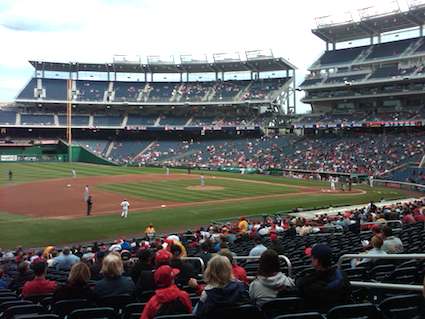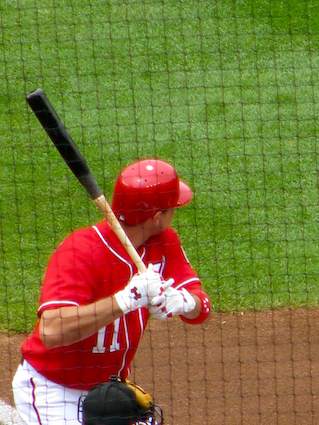Fair warning, little geographic content makes it onto Twelve Mile Circle today. Mostly I’ll focus on statistics. No, no, don’t go running for the door quite yet. It will be fun and actually the statistical slant will be relatively mild, grossly overly simplified with sweeping generalizations and involve no actual mathematics.
I went to a Washington Nationals baseball game yesterday evening. If you’re a baseball fan I already know what you’re thinking, but actually this is a happy story.
Final Home Game of the 2009 Season

Imagine the Nats down 3-4 at the bottom of the ninth inning, bases loaded, two outs, a batter facing a full count, and BAM, a walk-off grand slam homer with the Nationals taking the game 7-4 over the Mets.(1) The Post declared “the last scene of the 81st and final home game of the season was unlike any moment that preceded it, perfect and delirious…”
This was the last home game of the year, a final chance to catch a ballgame in Washington until next April. I’m not a huge fan of any given team. I have no loyalties. However, I do enjoy attending live sporting events. I love being part of the crowd, soaking up the atmosphere, participating in the pageantry, and drinking a couple of beers with friends. Buy me some peanuts and cracker jacks, and all that. I’d only been to one other game the entire season so I figured I should fit this last opportunity into my schedule when it was offered to me.
Earlier That Season

Oddly, the only other game that I’d happened to attend this year also featured a grand slam home run. That time, on May 24, 2009, it came off the bat of Adam Dunn. He put the Nats out front in the seventh inning. They left the field with a victory over the Orioles, 8-5.
Getting back to the title of this article, the Danger of Small Sample size, if one were to examine only these two instances one might conclude that the Washington National are a fantastic team producing a grand slam home run every game as they cruised to another victory.
Not As it Seems
Let’s get real. Grand slams don’t happen often. The chance of seeing one occur in two separate pseudorandom games — the only two games attended in an entire season — has to be considerably less than one percent. I’m sure the baseball statisticians out there could find the actual number of grand slams, the actual number of games, and the joint probability of two such occurrences. If there are any baseball math nerds out there who’d like to take this on as a challenge and post the calculation/results in the comments below, it would be a truly outstanding contribution. Until then I’m going to forgo precision and guess “it is fairly remote.”
Let’s look at the other improbable thought. This one is easy to dispel because the entire population is well known, and in fact is published widely every day. As of October 1, 2009, the Nationals have won 55 games and lost 103, with four games remaining in the regular season. This isn’t good. In fact it’s the worst in major league baseball. Any season with a hundred or more losses is considered pretty dismal, and the Nationals have accomplished this dubious achievement two years in a row.
Sample size of two: the Nationals are a great team.
Larger sample: well, not so much.
Either way, I’ll be out at the ballpark next spring. Maybe I’ll bring them some luck.
12MC Loves Footnotes!
(1)My apologies to those of you who live in parts of the world not familiar with this sport. It’s probably best to simply note that this was “an exciting and somewhat rare event“

Leave a Reply